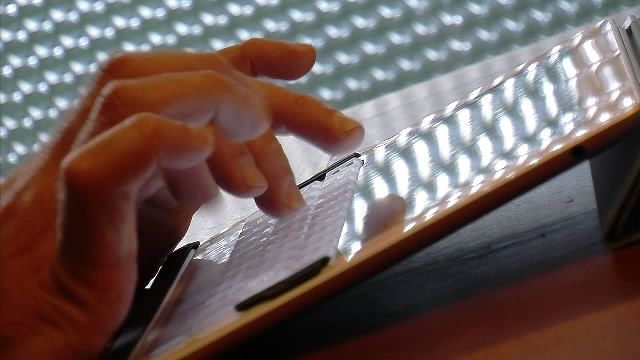Editor’s Note: This week we’re running a three part series by Steven Isaac, a programmer with an amazing resume including stints at Sun, Microsoft, and even a hardware start-up that brought the first (non-portable) tablets. For years he’s dreamed of an easy-to-use device with a full keyboard that slides out when needed and, together with a designer, he built the Touchfire, a fully funded Kickstarter project that has only 10 days to go before production begins.
We asked him to create a series of short posts about his experience with the Kickstarter process and offer you, the hardware hackers out there, some advice and best practices. Read part one here. The entire series will appear here.
I knew what I wanted – a soft, rollable keyboard for tablets – but I didn’t have an inkling how to get my keyboard idea made. That’s when I met Brad.
Brad is both a mechanical engineer and an industrial designer, a rare but extremely useful combination. He started his career at HP, and then went to the legendary design firm IDEO. In a strange twist of fate, Brad had done the mechanical design of the EO tablet while at IDEO. But our paths never crossed.
He went on to design everything from toothbrushes to Cray supercomputers, plus a wide assortment of mobile and digital camera accessories. He was now running his own design consultancy, and seemed perfect for the job.
Brad was confident that he could wrap up my project in short order; he had designed keyboards before. He proposed using silicone as the material, and designed the first version of TouchFire in a few weeks, using a traditional key design for a rubber keyboard.
Keyboard B1, as we called it, was a failure. No matter how hard you pushed on a key it wouldn’t actuate. My hacked together prototype worked better. It became clear that designing an all-silicone keyboard overlay that allowed users to rest their fingers on home row that was also easy to type on, was not going to be a snap. It would require fundamentally re-inventing how the tactile aspects of the keyboard worked. And we hadn’t even begun to figure out how to make it magically disappear at the user’s command.
But that was OK. Every significant project I’d ever worked on reached a point of hopeless despair somewhere along the line. It was time to make failure our friend.
I challenged Brad to design a keyboard overlay that worked better than my prototype. 19 attempts later, keyboard B20 finally achieved that goal. It still didn’t allow users to rest their fingers on the home row, but the typing experience had significantly improved. We brainstormed a dozen ways to quickly get the keyboard overlay out of the way, and settled on a mechanism that retracted the overlay when the user pulled a lever. We would build this into an iPad case.
Now we were cooking! I decided to spin up a separate company for TouchFire, and offered Brad an equity co-founder role. This meant that he would no longer be paid as a consultant. It was a big decision that he struggled with, and then agreed. We were off and running; what could possibly go wrong?
We found out a few months later. We were up to revision B38 by this time, and we still hadn’t cracked the puzzle of the home row rest keys. The way we were going was looking more and more like a dead-end. Meanwhile, the magic retraction mechanism was getting more and more complex, starting to resemble the rigging of a 16th century sailing ship.
We had to make a bold move. Brad proposed building a keyboard prototype where each individual key was a completely new design. We would try every crazy idea we could think of, and if none of them worked, TouchFire was toast.
